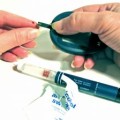Pre-Teens Get Healthier School Curriculum
As classes resume this month, eight major American universities are kicking off the largest diabetes study the country has ever seen. Under a program sponsored by the National Institutes of Health, more than 40 middle schools will be divided into two groups. The 11 year olds in the first group will be given healthier food in the school cafeteria and a more rigorous physical education program. There will be no changes for the other group. Researchers are using all kinds of gifts and money to get the children to sign up for blood tests and other measurements of their progress.
In a medical building with a sweeping view of downtown Portland, Doctor Lynn DeBar prepares herself for three years of intensive study. The scientist with Kaiser Permanente Center for Health Research says the nationwide scope of this investigation shows just how big a problem childhood diabetes has become in the United States.
"The rates of obesity have increased several-fold to the point where at least a third of the population, we're worried, either have problems of [being] overweight in this age range or at risk for problems." DeBar says that 20 years ago, type 2 diabetes was really only a problem for middle aged people, who'd enjoyed a lifetime of over-eating and under-exercising. That's not true anymore, she says, which is why things at dozens of schools around the country are going to start changing. As parents arrive for the annual "ice cream social" at Portland's Reynolds Middle School, medical staff let them know that there will be more fiber and fruit in school lunches this year, along with less sugary drinks and fewer fatty snacks. The parents are then ushered into the main hall where Melissa Durham, with Oregon Health and Science University, explains that in order to determine how much of a difference the change in diet and exercise might be making, researchers need the height, weight and waist circumference of their children.
Providing those measurements is optional because a blood sample is needed too, hence the incentives she outlines. "The child that participates also gets a $50 gift certificate for participating in the blood draw. Each child that participates gets one on the day of the blood draw. And that is because it is a little scary to get a blood draw and they will be fasting from midnight the night before." The kids will be offered another $10 for being measured again next year, in seventh grade. And if they stick with the program through the eighth grade, they get another $60. As a further incentive, kids who choose to take part get a chance to win a new bike.
"I was kind of wondering why they were going to pay?" says parent Michael Thrash, who admits he was skeptical before the presentation. "But what I really didn't understand was how are they going to know what was different. But now I understand this school gets a little better nutrition, a little more exercise. The other school just stays as they are and does the normal thing." With a little laugh, he says he was a bit worried the researchers would insist his child do something unhealthy, like sit and watch four hours of television or eat three bags of chips every night as part of the study.
As sixth graders ruminated over the benefits of gift certificates versus less soda and chips, there was no obvious groundswell of opposition. 11-year-old McKenzie Gunter summed up the kids' general feeling. "I think they're really good ideas because then we will grow healthier and we'll be taller and we won't have any problems." She says her parents want her to have a balanced diet. "They tell me to eat all my meat and green beans and everything," she explains, adding "they say I have to sit and eat them or I don't get to eat dessert." McKenzie and most Americans already know that healthy food and plenty of exercise is good for you, whether you're tackling diabetes or the common cold. So back in the office of Doctor Lynn DeBar the question is: Do we need another study? She says yes, pointing out that many U.S. schools are already making a lot of these changes on their own. "We want to know if you put in an organized program, that has all the pieces that are coordinated, so it's not just doing the PE programs, it's not just putting healthier things in the soda machine, it's not just teaching kids in health class about this. But you coordinate all those things together, and you figure out ways that you can take that message home and make sure the families are really aware of it, is that another step that really makes a difference in long-term health?" The hope is that before McKenzie and her friends graduate from high school, Dr. DeBar and her fellow researchers will be able to hand schools a complete nutrition and exercise curriculum. With such a program, the nation could begin to reverse the obesity epidemic and all its associated health problems.

